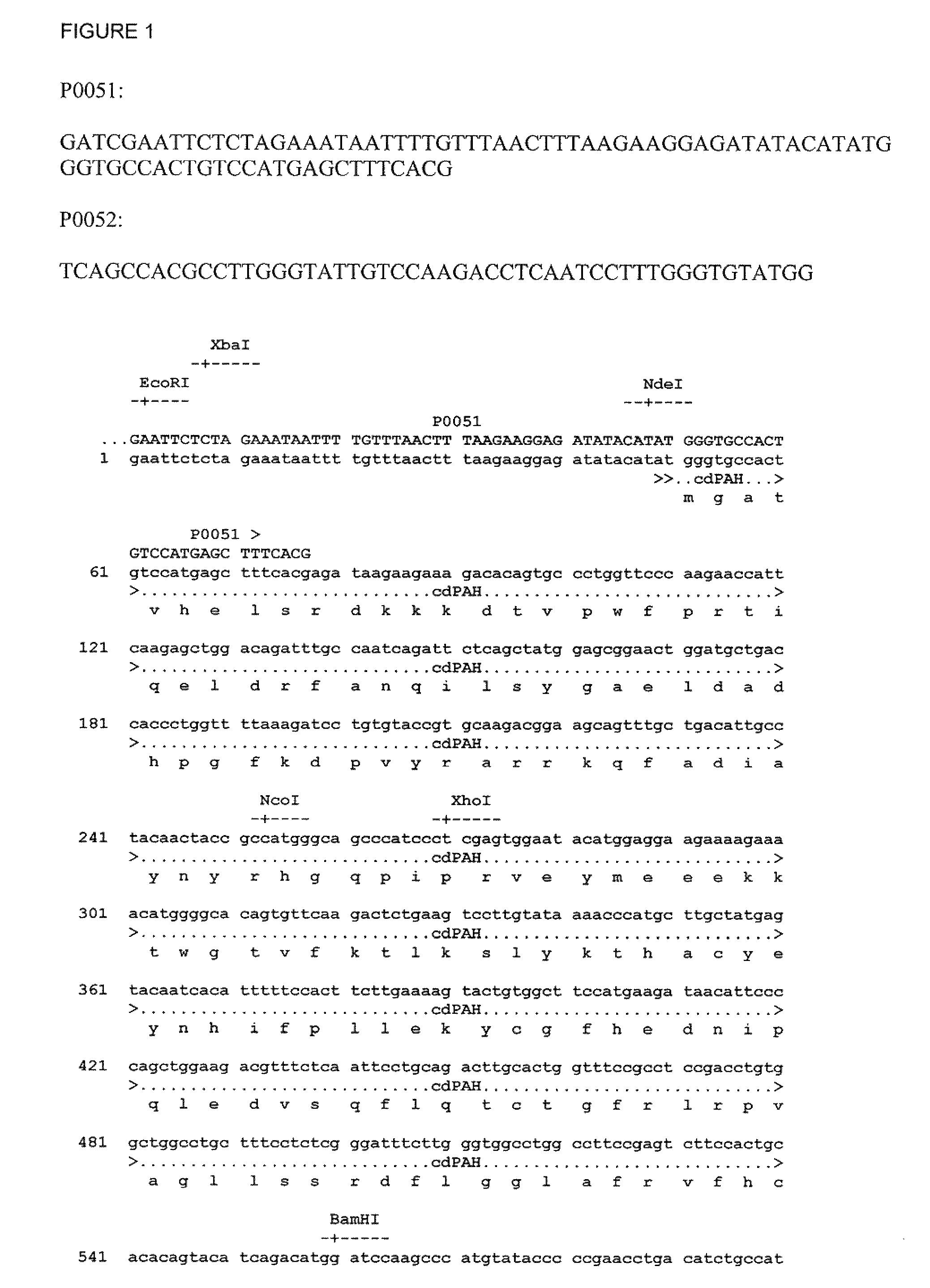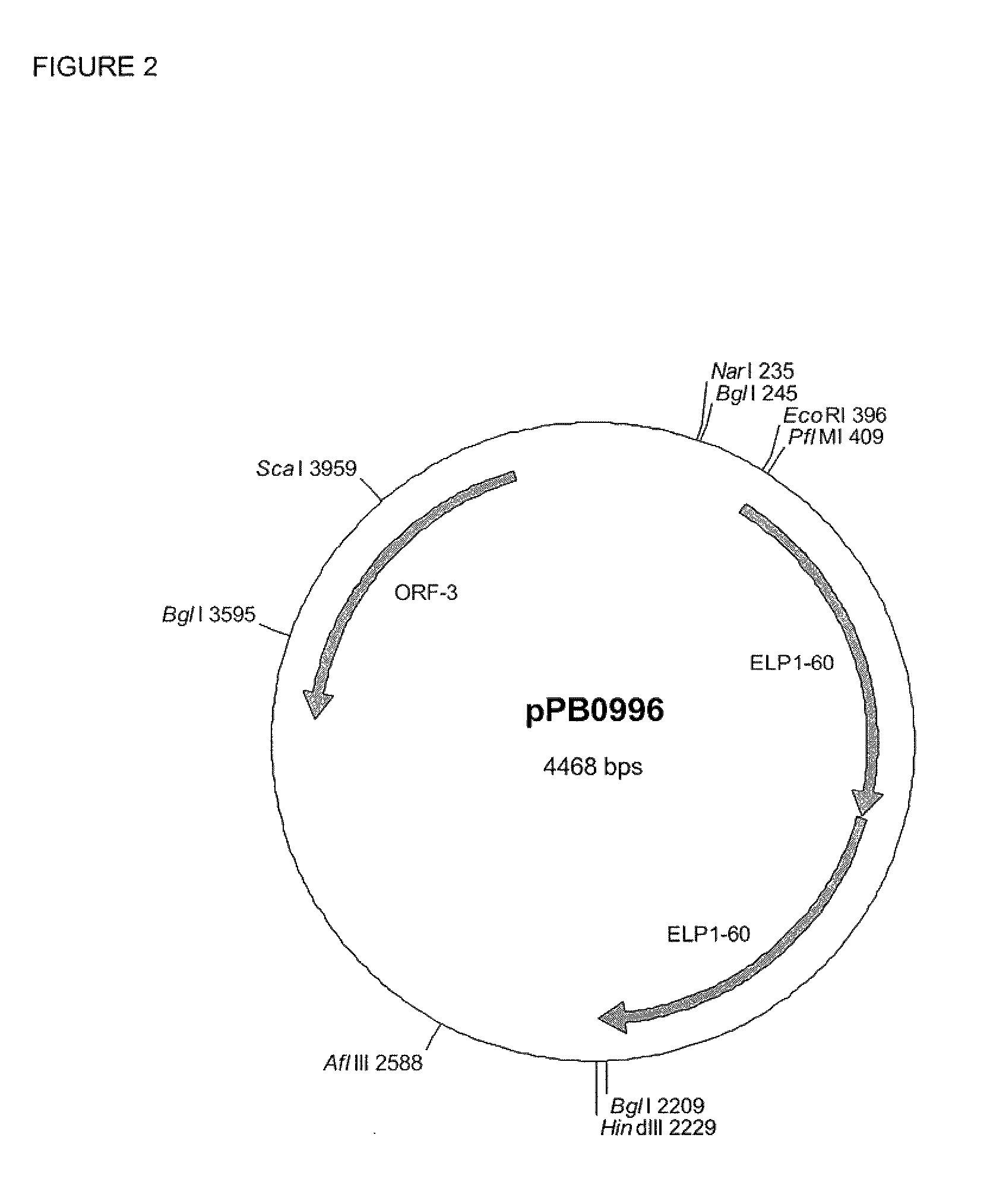Phenylalanine hydroxylase fusion protein and methods for treating phenylketonuria
a phenylalanine hydroxylase and phenylketonuria technology, applied in the field of disease, can solve the problems of physical handicap, cognitive disorders including mental retardation, neurodeficiency, etc., and achieve the effect of increasing the half-life or persistence in circulation
- Summary
- Abstract
- Description
- Claims
- Application Information
AI Technical Summary
Benefits of technology
Problems solved by technology
Method used
Image
Examples
example 1
N-Terminal Fusion with Residues 103-428 of Human PAH
[0109]The core catalytic domain of Human PAH (cdPAH or PAH 103-428) was synthesized by PCR from a cDNA clone (OriGene SC120014) with primers P0051 and P0052. This introduces modifications at the 5′ and 3′ ends for subsequent cloning steps. FIG. 1. The resulting PCR product was digested with the restriction enzymes EcoRI and PflMI and cloned into pPB0996 (ELP1-120) (FIG. 2), which had been digested with the same restriction enzymes to give pPB0998 (FIG. 3). The insert was DNA sequenced to confirm and check for any PCR induced errors. The PAH ELP1-120 expression cassette was recovered from pPB0998 by digestion with the restriction enzymes Xbal and BglI and ligated into pPB0913 (FIG. 4) digested with the same restriction enzymes to give the final pET based construct, pPB0999 (FIG. 5). This cloning results in the first VPGXG repeat (SEQ ID NO: 3) being truncated to GVG.
[0110]The DNA sequence for PAH was optimized for E. coil expression...
example 2
C-Terminal Fusion with Residues 103-427 of Human PAH
[0111]The core catalytic domain of Human PAH (cdPAH or PAH 103-427) was synthesized by PCR from a cDNA clone (OriGene SC120014) with primer pairs P0053+P0056 or P0054+P0055 to create two PCR products. The resulting PCR products were joined together by PCR with just the outer primers P0053 and P0054. This removes an internal HindIII site to enable the use of this restriction site at the subsequent cloning step. FIG. 6. The final PCR product was digested with the restriction enzymes BglI and HindIII and ligated into pPB0996 (ELP1-120), which had been digested with the same restriction enzymes to give pPB1000 (FIG. 7).
(SEQ ID NO: 19)P0053: GTCAGCCGGGCTGGCCGGGTGCCACTGTCCATGAGC(SEQ ID NO: 20)P0054: GTCAAAGCTTGCTAGCTTATCAGGTATTGTCCAAGACCTC(SEQ ID NO: 21)P0055: GAGAAGCCAAAACTTCTCCC(SEQ ID NO: 22)P0056: GGAGAAGTTTTGGCTTCTCTG
[0112]To modify the 5′ end of the expression cassette to give the correct start (MVPGVG . . . ) the plasmid pPB1000 w...
example 3
Expression and Enzymatic Activity of PAH-ELP Fusion
[0115]PAH (103-428)-ELP1-120 (designated PB0999) was expressed in E. coli and subsequently purified by temperature cycling. The expected molecular weight of 85 kDa as shown by SDS-PAGE (denaturing, non-reducing) was obtained. see FIG. 12.
[0116]PB0999 was tested for enzymatic activity. Conversion of phenylalanine to tryrosine by PB0999 was detected by OD450 nm (FIG. 13), as well as by phenylalanine-dependent oxidation of NADH (OD 340 nm). see Macdonald et al. (1990), PNAS 87, 1965-1967. (FIG. 14). Conversion of phenylalanine to tyrosine was also determined by RP-HPLC (Shimadzu C18 column) (FIG. 17).
[0117]Presence of tyrosine may be determined by increase in OD at 275nm. As shown in FIG. 15B, PAH-ELP converts phenylalanine to tyrosine, as determined by an increase in OD275. The PAH-ELP comprises PAH(103-428) with 120 pentamer ELP repeats, and exhibits a specific activity of 878 nmol tyrosine / min·mg. Compare with 1200-1502 nmol tyrosin...
PUM
| Property | Measurement | Unit |
|---|---|---|
| molecular weight | aaaaa | aaaaa |
| transition temperature | aaaaa | aaaaa |
| transition temperature | aaaaa | aaaaa |
Abstract
Description
Claims
Application Information
 Login to View More
Login to View More - R&D
- Intellectual Property
- Life Sciences
- Materials
- Tech Scout
- Unparalleled Data Quality
- Higher Quality Content
- 60% Fewer Hallucinations
Browse by: Latest US Patents, China's latest patents, Technical Efficacy Thesaurus, Application Domain, Technology Topic, Popular Technical Reports.
© 2025 PatSnap. All rights reserved.Legal|Privacy policy|Modern Slavery Act Transparency Statement|Sitemap|About US| Contact US: help@patsnap.com



